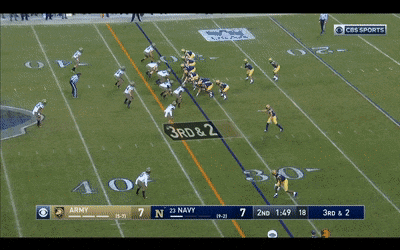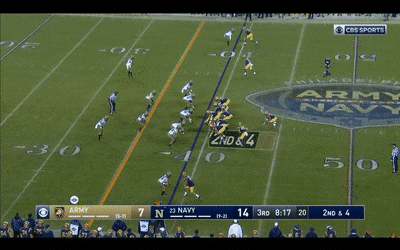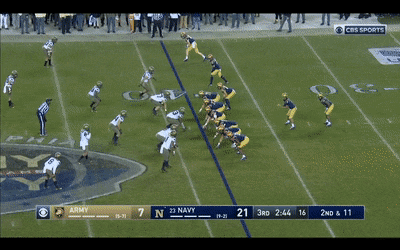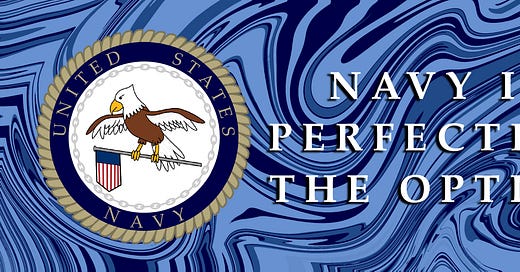Navy Is Perfecting The Option
With Malcolm Perry at the helm, Navy was on the cutting edge of option innovation.
The definition of “triple option” in college football has become almost impossible to discern in recent seasons, as the line between traditional offenses and option offenses has blurred to a degree never seen before.
The proliferation of the “spread option” as it is frequently referred to is largely to blame for the blurring. Teams like Auburn, Tulane and Ole Miss have been utilizing triple option concepts for years (as Chip Kelly and Urban Meyer did to great success in the late 2000s and early 2010s), but utilizing them out of a traditional spread formation. In doing that, those schools are able to continue to identify as spread rather than as option, and continue to be able to recruit the same players that their non-option contemporaries are pulling in.
This is especially important at a place like Auburn, where avoiding the “triple option"“ tag is crucial to retaining both standing in the national conversation, and a bizarre sense of pride among the fan base.
Auburn, along with quite a few others have managed to see their offenses defined with the blanket spread term. The truth, of course, is that they’re running the triple option, just as plenty of powerhouse programs did all the way through the 80s, when it fell out of vogue with the rise of faster defenses. It may not be defined that way, but all of the concepts are there, and even though these new option teams pass more frequently than the old ones did, their offenses are designed the same way as the old option offenses were.
They manipulate defenses by forcing them to defend multiple options on the same play, and then further their numbers advantage by isolating several defenders as the “read” defenders, giving blockers the chance to get to the second level sooner. It’s an approach that works, has always worked, and likely will always work, and it’s a shame that there’s a stigma around the “triple option” term in college football.
The few schools that aren’t ashamed to be branded as “triple option” are the service academies, who have been doing this for decades, and recognize that running the option is basically the only way to win games with service academy recruiting limits. Air Force, Army and Navy have been running a true, traditional triple option for years, and it almost seems as though the concept has become synonymous with those programs, despite its rich history at some of the best schools in the sport’s history.
Funny enough, despite being branded as pure triple option, one of those schools has quietly shifted to something much closer to spread option, and the other two may follow the lead shortly after.
In 2019, with Malcolm Perry leading the way, Navy was unquestionably a spread triple option team, and looked a lot more like Auburn or Tulane in the rushing department than it did Army or Air Force. A lot of that was thanks to Perry, who developed from a guy that was literally pulled out of the stands in the middle of a game into one of the finest option quarterbacks in America.
Perry’s ability to manipulate defenders, mixed with his game changing speed gave Navy offensive coordinator Ivin Jasper quite a bit of room to experiment. He was also helped by the fact that he had played just about every position on the offense, and while 2019 was his only year as a starting quarterback, he had been a huge part of the offense since 2017.
To best optimize Perry’s skillset, Navy implemented a ton of spread into its system, giving him more time to read the defense before making a decision, and, more importantly, allowing him to build up more speed in the backfield before needing to beat any defenders.

As it is in a lot of spread option offenses, Navy’s base play was a modified read option, though the Midshipmen have put an interesting spin on it. Perry looks like he’s reading the backside linebacker, No. 54, as the QB would on an RPO, rather than the end as you usually would on a read option. The blocking on that end isn’t very good, but there is an attempt made, which would indicate that he’s not the player being isolated.
While it’s different, this actually makes a lot of sense. Because Navy is trying to get Perry into the B gap where the pulling guard evacuates, sealing off the edge rusher with the play side tackle and putting that linebacker in a position where he has to make a decision is the only way to create room for Perry. If the linebacker stays in place, sealing that edge rusher isn’t going to hurt Navy, and the halfback would still be running into a numbers advantage, with the pulling guard, three other linemen and a wide receiver all blocking for him, and no second linebacker to deal with.
You could call this a midline read option, though Navy isn’t reading the tackle, but the thought process is the same.

Now, that isn’t to say that Navy didn’t have more traditional read options in the offense too. Here, Perry is reading the isolated edge rusher, and pulls the ball for a keep once that edge rusher flashes inside rather than setting an edge, giving Perry plenty of space to pick up the first down.

While having the standard spread option stuff was necessary to build the offense around, it was the unique looks that really defined this offense and made it as good as it was. Navy mixed in spread option concepts with that more traditional flexbone style that Army utilizes to create stuff like this.
I have no idea what to categorize this as. It’s almost a singleback read option, though the halfback isn’t as far back as he would be in an ace look, and he has a hand on the turf, as he would in a traditional option formation. Without slotbacks attached to this formation is certainly isn’t flexbone either, so it’s almost like a pistol look, with the quarterback moved up under center.
With any name, it’s amazing. Navy isolates and reads the edge defenders by pulling the play side guard and tackle in, overloading the center of Army’s line and creating a five-on-four numbers advantage if that edge rusher stays in place. In this case, he bites in, so Perry pulls the ball. With trips to the back side of the play that Army has to account for, Perry is running into nearly completely open space once he pulls the ball. It’s a phenomenal play design.

It works when that edge defender stays home, too. The right side of the line takes on the nose tackle, end and play side linebacker, while the pulling guard and tackle manage the other end and the edge rusher on the playside, leaving just one linebacker anywhere near the play, and he has to fight through a mess to get even close to the ball carrier.
When dealing with seven guys in the box, Navy, with five blockers, was able to use defender isolation and clever blocking to completely even out the numbers game, without dedicating a single tight end or halfback to blocking. Erasing two defenders without needing to block them is basically the ultimate goal of the option, and Navy has it down to a science.

The last of the read option concepts really worth looking at in this offense is this one, run from the pistol, which looks a lot like the traditional pistol read option, though it has a power twist to it. Rather than bouncing outside when he pulls the handoff back, Perry just follows his halfback into the hole, using him as a lead blocker, almost as he would on a quarterback draw.
This actually may be a designed quarterback run made to look like a read option, but it does its job well, holding the edge defender and play side linebacker in place for long enough to allow Perry to dart into the gap, and to give his linemen time to get to the second level. This isn’t the sort of play that will work every time, but it’s a nice change of pace.

Navy has a couple other designed runs in the playbook, including this, one of the few true flexbone looks that the Midshipmen showed against Army last season, near the end of the game as they were trying to burn some clock. It’s a basic bootleg, with all three halfbacks overloading the play side to block for Perry, making this one of the more grind-it-out, power runs that you’ll see anyone putting on tape in 2019.
The tight end, tackle and guard on the play side are all blocking down to create a seal, leaving the edge defender, play side linebacker and safety as the assignments remaining for those lead blockers. The motioning slotback picks up the linebacker, the edge defender gets caught in the down block, and the safety isn’t quick enough to keep up with Perry. Again, not an evergreen play, but good in moments and a very fun reminder of what football used to be.

The crown jewel of this game, and my favorite play in the playbook is this, which looks a whole lot like a power read with a pitch tag attached, though I’d imagine Navy has a much more creative and fitting name for it. After motioning the h-back into the backfield from a spread look to create a split backfield, the typical next move would be a defensive end isolation, with one back looking to hit the B gap, while the other gets horizontal to present a pitch option on the other side of the field. This is a super common triple option look from spread, and essentially Auburn’s base play.
Instead, Navy subverts those expectations, running the first read as it would a power read or inverted veer, with the halfback serving as the outside threat, and the quarterback aiming for that B gap, while reading an isolated end. The end reads this and bits end, which would usually force a handoff, but instead, Perry holds that read for an extra second, and just takes off behind his halfback, now serving as a lead blocker along with a pulling guard, with that H-back trailing as a pitch option.
A lot of college football’s best plays are designed in a way that make you think “oh yeah, of course that makes sense, why didn’t I think of that?” It’s true of the power read, which Meyer rode to three championships, it’s true of the wishbone formation that Barry Switzer used in the 70s and 80s, and it’s true, frankly, of a lot of the things I talk about on this newsletter. Good football design is usually good because it makes perfect sense physically, and a lot of the time, the best plays come about because someone really smart, like Jasper, just happens to stumble upon it.
This is one of those plays. It’s flawless. The extra blockers with the halfback and pulling guard, the h-back serving as a pitch option, the multiple subversions of defensive expectation, all happening within the span of a second, it’s just brilliant. It’s a play that you could build an entire offense around, and I’d be willing the bet that someone is going to, sooner than later.
The fact that this is just a small piece of Navy’s massive arsenal is a testament to the kind of innovation that can come from understanding the history of the game. Navy’s staff understands and appreciates the option and they understand that there’s a damn good reason that the option has lived this long.
Up next: Joe Moorhead’s Tuddy Machine
Graphic by Kristen Lillemoen




Thanks for doing these film studies. I'm learning a lot. And I'm not kidding.